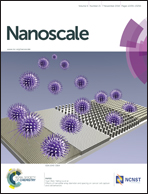“Smart” theranostic lanthanide nanoprobes with simultaneous up-conversion fluorescence and tunable T1–T2 magnetic resonance imaging contrast and near-infrared activated photodynamic therapy†
Abstract
The current work reports a type of “smart” lanthanide-based theranostic nanoprobe, NaDyF4:Yb3+/NaGdF4:Yb3+,Er3+, which is able to circumvent the up-converting poisoning effect of Dy3+ ions to give efficient near infrared (980 nm) triggered up-conversion fluorescence, and offers not only excellent dark T2-weighted MR contrast but also tunable bright and T1-weighted MR contrast properties. Due to the efficient up-converted energy transfer from the nanocrystals to chlorin e6 (Ce6) photosensitizers loaded onto the nanocrystals, cytotoxic singlet oxygen was generated and photodynamic therapy was demonstrated. Therefore, the current multifunctional nanocrystals could be potentially useful in various image-guided diagnoses where bright or dark MRI contrast could be selectively tuned to optimize image quality, but also as an efficient and more penetrative near-infrared activated photodynamic therapy agent.


 Please wait while we load your content...
Please wait while we load your content...